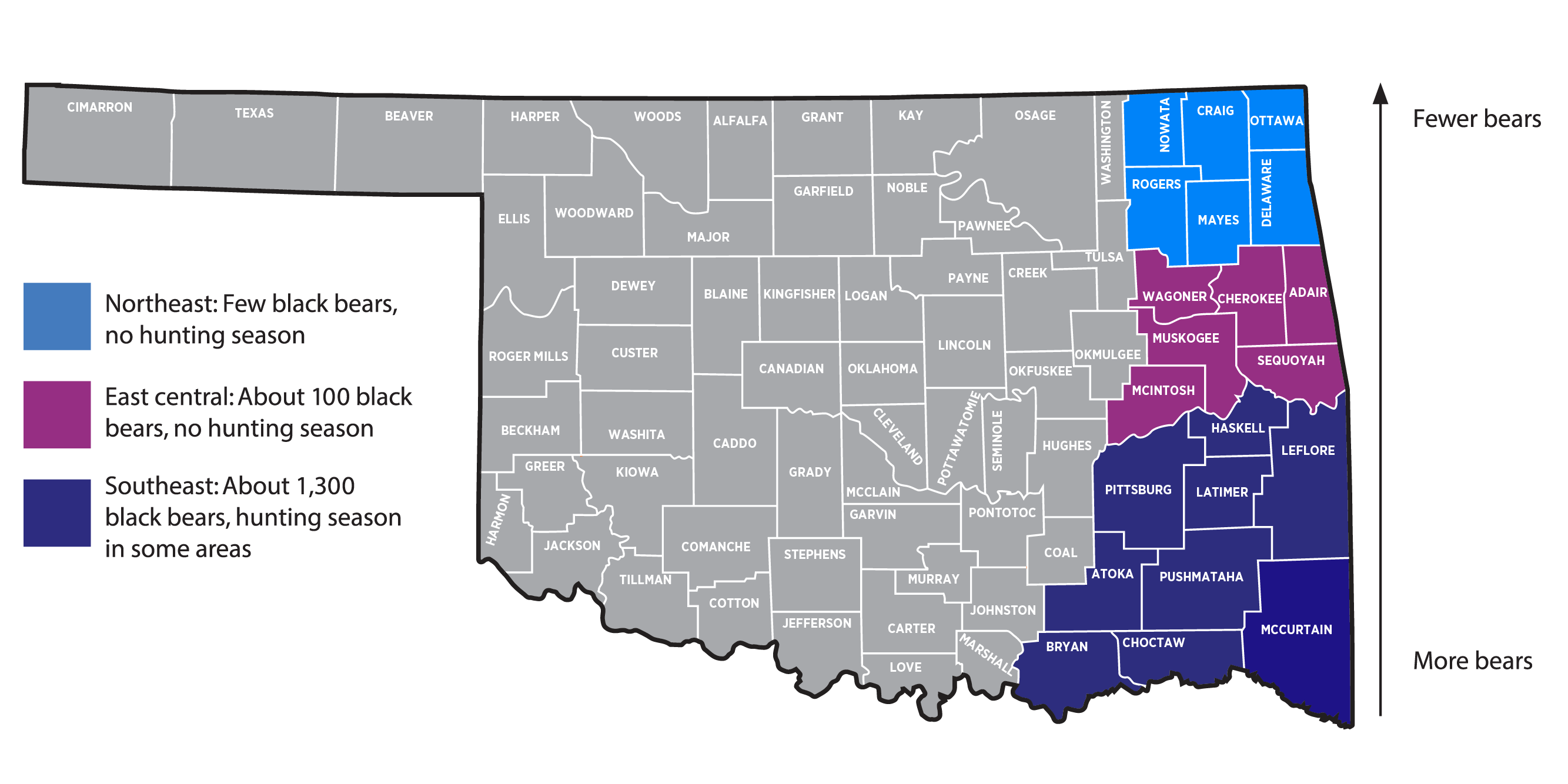Sightings of large mammals can bring joy and excitement, but their presence may carry some risks such as property damage and threats of bodily harm to pets, livestock and humans. How local residents perceive these risks can impact their tolerance of black bears. Black bear tolerance refers to the maximum number of bears that local people are willing to live with. Two populations of black bears are recolonized in eastern Oklahoma in the Ozark and Ouachita mountain regions. This brings new chances for humans to experience the many benefits of living in close proximity to black bears, such as viewing and hunting, as well as the potential for negative interactions between humans and bears. To investigate how Oklahomans tolerate black bears, a sample of residents in eastern Oklahoma was surveyed about various perceptions of risk from bears and demographic (i.e., age, gender, race) factors. This Fact Sheet highlights major findings from recent research on the status of black bear populations in Oklahoma and how humans perceive them.

Figure 1. Black bear at a bucket trap.
Highlights
Status of black bears in Oklahoma
- There is a growing population of approximately 1,300 black bears in the Ouachita Mountains of southeastern Oklahoma, which has been open to a hunting season since 2009.
- The Oklahoma Ozark black bear population in east-central Oklahoma is skewed toward younger bears, with a median age of three years for both sexes and a ratio of 2.4 males to every one female. Current reproduction in this population does not compensate for mortality rate, so it is dependent on bears moving into Oklahoma from Arkansas to keep the population sustained.
- In the Oklahoma Ozark black bear population, female black bears are sensitive to habitat fragmentation and establish home ranges in places that are less disrupted by human activity. In contrast, male bears do not appear to be sensitive to habitat fragmentation in their home ranges. This pattern is important for future population growth and expansion.
Public perceptions and tolerance for black bears
- In general, residents are willing to tolerate more black bears than they currently perceive to live in their region.
- Prior to taking the survey, about 76% of respondents were aware there might be black bears in the areas they lived.
- Residents who were more willing to change the way they store their bird feeders and garbage with the goal of reducing human-bear conflicts were more tolerant of black bears.
- Residents who held positive attitudes toward bears also were more tolerant.
- People with more formal education were more tolerant of black bears. Men were more tolerant of bears than women.
- People who perceived more benefits with black bear coexistence were more tolerant of them.
Social acceptance across the regions
- Residents in east-central and southeastern Oklahoma have the most potential currently to coexist with black bears.
- Tahlequah is in Cherokee County near the east-central Oklahoma black bear population. Residents in Tahlequah were more tolerant of black bears compared to surrounding areas.
- Tolerance for bears was lower in and around city of Nowata, although there is no established resident black bear population in this area.
- Confidence in the Oklahoma Department of Wildlife Conservation (ODWC)’s ability to manage black bears was higher near Tulsa and lower in rural areas, specifically southeastern Oklahoma.

Figure 2. Study area in eastern Oklahoma showing black bear population size and hunting seasons at time of study.

Figure 3. Regional variation in respondent perceptions of the black bear population size in their area. The vertical axes represents a range of increasing black bear abundance. Situation 1 depicts a population estimate with no black bears, and five represents the maximum number of black bears the region’s habitat can sustain.

Figure 4. Variation in perceptions concerning different black bear population size. The vertical axes represents a range of increasing black bear abundance from 1 (a population estimate with no black bears) to 5 (the maximum number of bears the region’s habitat can sustain).
Conclusion
The survey suggests residents generally were willing to tolerate black bears at somewhat higher population sizes than they currently perceive to exist in their area. Residents with more formal educational experience and those who live in urban areas were more tolerant of black bears, while rural residents were more concerned with how black bears would be managed and were less tolerant of black bears. Men were considerably more tolerant of black bears than women, suggesting that outreach targeted towards women might have great potential to improve tolerance, along with programs to demonstrate steps residents can take to minimize negative interactions with black bears.
Acknowledgement
The work was financially supported by the Oklahoma Department of Wildlife Conservation Wildlife Restoration Grant F17AF00264 (W-187-R-1). Thanks to the field biologists and Extension professionals for providing feedback during the survey design and implementation.
The authors want to thank all landowners who participated in the study.











































